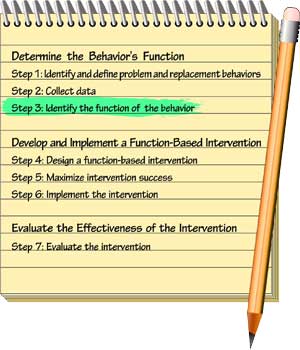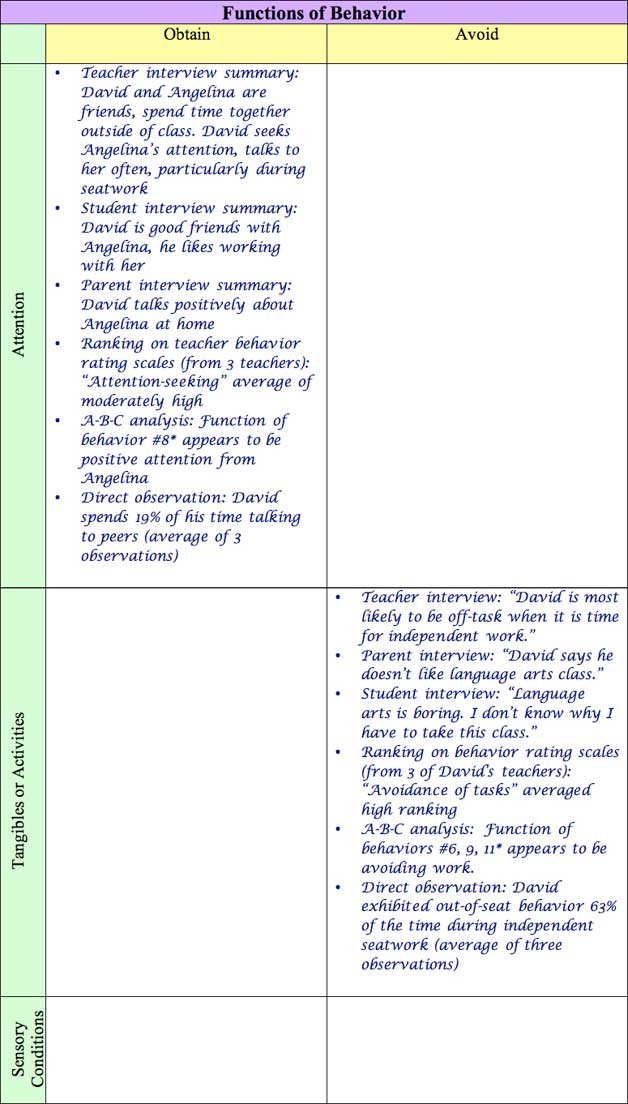How can Ms. Rollison determine why Joseph behaves the way he does?
Page 8: Identify the Function of the Behavior
 Once school professionals have collected the data on the student’s behavior, the next step is to identify the function of that behavior. For example, when they consider David and Joseph, they need to determine:
Once school professionals have collected the data on the student’s behavior, the next step is to identify the function of that behavior. For example, when they consider David and Joseph, they need to determine:
- Why David is off-task
- Why Joseph makes rude comments
Remember, nearly all behavior occurs in order either to obtain or avoid something: attention, a tangible item or an activity, or a sensory condition.
Compile the Functional Assessment Data
Educational professionals can use a functional assessment matrix to help analyze this information. The matrix will assist them in organizing and categorizing the data from any of various sources (e.g., interviews, rating scales, ABC analysis, other direct observations) to help determine the function of the behavior. If much of the information falls into the intersection of the cells labeled “Obtain” and “Attention,” then it is possible that the function of the behavior is to get attention. Conversely, if much of the data fall into the intersection of the cells labeled “Avoid” and “Tangibles or Activities,” then it is likely that the function of the behavior is to avoid tasks or activities.

Transcript: Kathleen Lane, PhD
At this stage in the process, you’ve now been collecting data using a variety of functional assessment tools. And when we put all this information together, it can be really overwhelming, particularly when you’re first getting started in doing functional assessment-based interventions. You’ve acquired quite a bit of information about children, and you’re trying to figure out, “Gosh, what does it all mean?” Now, the tool that you have in front of you now is this function matrix, and this was developed by John Umbreit and his colleagues at the University of Arizona. And the nice thing about this is this provides a very succinct way of organizing all the data that you’ve collected on the child so that you can get a very clear picture as to why the student is doing what they’re doing—in other words, identifying the motive for the behavior. Now, what you would do is you would take all this information from your functional assessment tools and you would begin by saying, “Where does this fit?” For example, if you look at the top of the matrix, you’ll see two columns. The first one says Obtain. Information that goes into that column is going to suggest that the child is trying to obtain attention or obtain access to an activity or a tangible or trying to obtain some kind of sensory information or experience—kids that hand-slap or hum, that type of thing. In the next column, you see Avoid. The kid that’s consistently sick before needing to go out for PE or sick before going to the cafeteria. They may be trying to avoid social attention. You also have avoiding tangibles or tasks, like they’re trying to avoid some type of experience that’s either too hard or too easy or just simply not reinforcing enough for them. And, lastly, you’ll have the kids that like to avoid sensory conditions. Sometimes even with kids with autism, like if you see them walk into the cafeteria, they’ll put their hand over their ears ’cause they’re trying to block out some of the noise that’s in that environment.
Now, view David’s completed functional behavioral assessment matrix and watch the movie below to hear Kathleen Lane discuss it in greater detail (time: 3:29).

Comments: *Numbers refer to observed behaviors on the A-B-C observation form.
Transcript: David’s Behavioral Assessment Matrix
Now, what you would do is you would take all this information from your functional assessment tools, and you would begin by saying, “Where does this fit?” So I’d start with the teacher interview, and I would read through the questions, and I would look for evidence of this child trying to either seek or to avoid something. So, for example, you see it says, “teacher interview summary,” and it says, “David and Angelina are friends. They spend time together outside of the class. David seeks Angelina’s attention and talks to her often, particularly during seat work.” All that information from the teacher interview would suggest David is accessing peer attention from Angelina. That’s why that information is written there. You would do the same type of thing with information gleaned from the student interview. For example, it says from the student interview that “David is good friends with Angelina, and he likes working with her.” So, again, that statement could get written in that box that says that he’s trying to access attention from that peer. Same thing in the parent interview was that David talked positively about Angelina at home. All three interviews support that notion that he likes accessing her attention. The behavior rating scales also indicate that he was in the average to moderately high range on attention seeking behavior, according to three different teacher’s reports. And it’s important to realize that not every single interview comment is going to go into one of these six boxes or cells, but this is how you organize the information. The next thing we like to look at is how to use the ABC data that are collected as part of the functional assessment process. You could go back and look at your ABC data, and each instance that David engaged in off-task behavior you would simply number those “1, 2, 3, 4, 5.” And let’s say he did that ten times during your observation sessions then you could calculate percentages or simply write in the number of times that it occurred for each instance. The direct observation data suggest that he was spending 19 percent of his time talking to his peers within an average of three observations. But if you look further down in the matrix, you’ll see that the majority of his time was actually spent escaping the independent activity of seatwork. They indicate that he was away from that task 63 percent of the time. And the nice thing about this matrix is, at just a simple glance, you can see that the majority of the information falls into two cells or boxes. So if I was writing this, I would be looking at this and thinking, “Wow, he’s doing this definitely to escape some task, but he’s also getting some attention.” And I can tell that in particular by the percentage of time that he’s spending accessing peer attention is less than the percentage of time that he has spent escaping the task at hand. So, when I would get ready to summarize this statement, I would say something to the effect of “David’s out-of-seat behavior is maintained primarily by ‘escape from task’ and to a lesser extent ‘accessing peer attention’ ” because it has two functions. But you can determine which is the primary function by looking at the data that are aggregated, or put together, in each of these cells.
Analyze the Functional Assessment Data
When they examine David’s matrix, the S-Team notices some interesting patterns. A great deal of information falls into two cells: the avoid/ tangibles or activities cell and the obtain/ attention cell. In many cases, behaviors can serve more than one function. Team members hypothesize that David’s primary motivation is to avoid doing independent work. However, the team determines that there may be a secondary motivator: to obtain attention from his peers, in particular from Angelina.
 Given these results, the team develops the following hypothesis statement about David’s behavior:
Given these results, the team develops the following hypothesis statement about David’s behavior:
The primary motivator for David’s off-task behavior (e.g., walking around the room, talking with peers) is to avoid class work. To a lesser extent, he also seeks to obtain peer attention.
For Your Information
If a student engages in more than one behavior, the team may need to consider the intensity of each. For example, consider a student who engages in two behaviors—daydreaming and swearing—to avoid certain tasks. Though the daydreaming behavior may be more frequent, the swearing may create a more disruptive environment, leading the team to address it first.
Activity
 Read the functional assessment matrix of Joseph’s behavior. Why do you think Joseph makes sarcastic, teasing comments during class? Explain your reasoning.
Read the functional assessment matrix of Joseph’s behavior. Why do you think Joseph makes sarcastic, teasing comments during class? Explain your reasoning.
|
Functions of Behavior |
||
| Obtain | Avoid | |
|
ABC analysis: 9 out of 10 comments were reinforced by laughing or attention from classmates. Ms. Rollison interview: “Joseph seems to enjoy the attention from his classmates.” Joseph interview: “I like making people laugh. It makes me feel like people like me.” Rating scale: Attention ranked very high. |
||

Kathleen Lane, PhD
Professor of Special Education
University of Kansas
Transcript: Kathleen Lane, PhD
Now that you’ve had a chance to practice completing a function matrix with Joseph’s data, you can see that this is a really clear-cut case. And as you look at this you can see that Joseph’s target behavior is maintained by access to attention. And as you look at the specific information in the box we can see that the teacher interview makes it clear that he enjoys attention from his classmates. Joseph himself says quite honestly, “I like making people laugh, it makes me feel like people like me.” And on the behavior rating scale, “attention” ranked very high as well and as you looked at the ABC data that were collected there were ten instances in which he was accessing peer attention for exhibiting his target behavior. So nine out of ten comments were reinforced by laughing or attention from classmates. And you can summarize data this way by saying, “9 out 10,” or if you wanted to you could actually write the number that corresponded to each instance of the target behavior in that box.